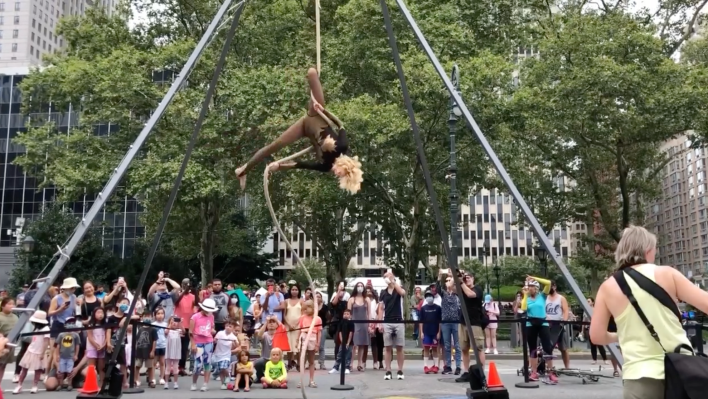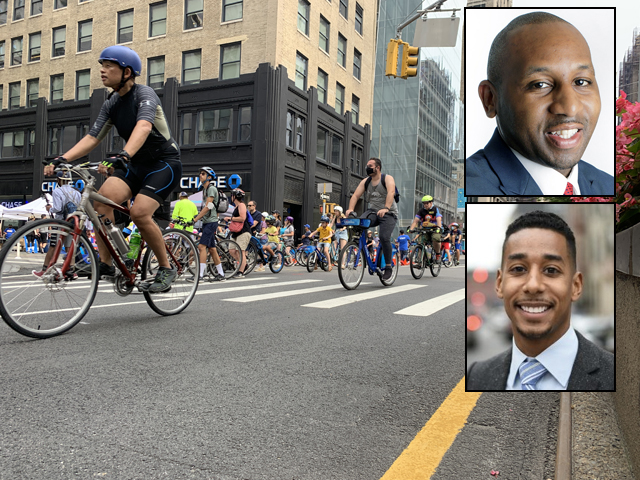Nothing succeeds like success.
The presidents of Brooklyn and Queens are urging the city to share the love of the popular, Manhattan-only "Summer Streets" program with the most populous boroughs — an idea which immediately ignited activists.
"Every year, we see how much New Yorkers enjoy the car-free street and associated activities, and we are writing to ask you to bring this beloved event to our respective boroughs in 2023," Antonio Reynoso and Donovan Richards jointly wrote to Transportation Commissioner Ydanis Rodriguez last week. "Given that more than 300,000 New Yorkers benefit from this annual event in Manhattan, we believe there is demand to expand to the boroughs."
The pair couched the proposed expansion as a matter of fairness and equity: "As advocates for open space and transportation equity, we believe this is an opportunity to reach many more New Yorkers who may not be able to easily access Manhattan," the officials wrote in the Sept. 2 letter.
The DOT told Streetsblog that it would review the request and discuss possible plans for expansion with the relevant parties.
Summer Streets runs a miles-long car-free corridor from the Brooklyn Bridge northward along Centre Street, Lafayette Street, and Park Avenue for a half-day on three Saturdays in August — and it might be the most popular thing the DOT does all year. From its inception 14 years ago, the program hit the ground running — and walking, biking, tumbling, stretching, face-painting and dancing, bringing thousands of New Yorkers into the streets in a joyous, impromptu parade stretching half the length of Manhattan.
Another spectacularly successful #SummerStreets today, with eight miles along the East Side of Manhattan car-free, packed with NYers running walking, rolling, biking & scooting.
— Mark D. Levine (@MarkLevineNYC) August 20, 2022
Next year let’s make this happen *every* weekend throughout the summer! pic.twitter.com/XGGXz1okOk
The program took a hiatus during the pandemic, but came back stronger: it expanded by two miles, to 109th Street in East Harlem, providing more than eight miles of car-free streets — although it did not expand days and hours, as many have long hoped.
Advocates have argued that New York can certainly do better — especially given that Montreal, Paris, Bogata and other cities routinely maintain long stretches of car-free roadways all day every summer.
"Next year let's make this happen *every* weekend throughout the summer!" Manhattan Borough President Mark Levine tweeted.

Because one of the Manhattan terminuses of Summer Streets is the Brooklyn Bridge, some Brooklynites started dreaming about having it continue onto the Brooklyn Bridge bike lane and then down to Atlantic Avenue and then Fourth Avenue to Bay Ridge. In Queens, the car-free street could go over the Queensboro Bridge and easily connect to Northern Boulevard.
"Whose streets? Our streets! Or at least they should be," said Brooklyn cycling activist and parent leader Justin Krebs. "Summer Streets give us a different way to envision our city, one that prioritizes a diverse range of uses and needs above car traffic and allows us to imagine and experience New York in a different way. But less theoretical and more practical: It just gives our kids places to play, allows us to stretch our legs, and provides a chance to get outdoors without leaving the city. It's room to breathe; it's a way to build community, and it's a bit more living room in a city where summer can be stifling.
"It's also a great way for more parents to have a chance to teach their kids to bike," Krebs continued. "Not everyone can schlep their bike to a park easily, so the more places there are to learn, the more future bikers, the better for everyone."
Juan Restrepo, a Queens organizer for Transportation Alternatives, said that "it's long overdue for Mayor Adams to expand the program beyond a few hours on a few days in only one borough," adding, "at a minimum, there should be Summer Streets in every borough, for many more hours, in a network that connects to protected bike lanes, greenways, and bridges."
And, not unimportant, Summer Streets is cheap at the price as city programs go.
The DOT declined to offer a top-line figure for the program's total operational costs which are divided among several departments, but it said it allocates $500,000 to produce Summer Streets, which covers event planning, day-of contractor staffing and programming. Sponsors also kick in some funds to help with programming costs.
The Department of Sanitation, which cleans up before and after the Summer Streets events, last year spent $70,825 on those activities, according to a spokesman. The NYPD did not respond to a request to quantify its operational role. Many officers patrol the route of the almost entirely crime-free event.
One advocates said he was "elated" to see the beeps' letter.
"Summer Streets is a wildly popular program and New Yorkers outside Manhattan deserve to enjoy it, too," said Jackson Chabot, the director of public-space advocacy of Open Plans (a sister organization of Streetsblog). "Many Brooklyn and Queens neighborhoods are especially in need of these safe and joyful spaces, so expanding the program would fill a much needed gap. We are energized by this administration’s East Harlem expansion; now, we need to expand Summer Streets beyond Manhattan.”
— with reporting by Christopher Robbins






